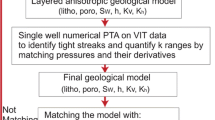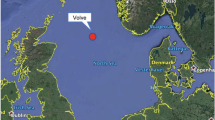Abstract
Static reservoir modeling for optimizing the strategies of hydrocarbon field developments using seismic data and well logs is the focus of this study. The static reservoir modeling is conducted to estimate reservoir properties of the Upper Sarvak formation in one of the offshore oil fields in the Persian Gulf. The Sarvak Formation with middle Cretaceous age is considered as one of the most important productive oil and gas reservoirs in the south and southwest Iran. In this study, we have used seven well logs and 3D seismic data in geostatistical methods for reservoir modeling. The petrophysical parameters such as effective porosity and permeability have been estimated, using the sequential Gaussian simulation method. The evaluation of petrophysical parameters in the reservoir layer shows that the mean effective porosity and permeability are 12.75% and 51.5 mD, respectively. The evaluation of petrophysical parameters from the reservoir characteristic viewpoint demonstrated that a zone called A2 has the best reservoir quality. The well-log validation with core data has been achieved by a cross-validation method. The correlation coefficients derived from the permeability and core data are 86% and 81% for wells w-01 and w-03, respectively, which show that the Sequence Gaussian Simulation is an acceptable method. The result of this study can provide useful information for the development of hydrocarbon exploration studies and reservoir simulation models in this oil field.













Similar content being viewed by others
References
Abdel-Fattah M, Tawfik A (2015) 3D geometric modeling of the Abu Madi Reservoirs and its implication on the gas development in Baltim area. Offshore Nile Delta, Egypt
Aizebeokhai AP, Olayinka I (2011) Structural and stratigraphic mapping of Emi field, offshore Niger Delta. J Geol Min Res 3(2):25–38
Alavi M (2004) Regional Stratigraphy of the Zagros Fold-Thrust Belt of Iran and Its Proforeland Evolution. Am J Sci 304:1–20
Al-Husseini MI (2007) Iran's crude oil reserves and production. GeoArabia 69–94
Alsharhan AS, Nairn AEM (1997) Sedimentary basins and petroleum geology of the middle east. Elsevier, Netherlands
ArabAmeri F, Soleymani H, Tokhmechi B (2019) Enhanced velocity-based pore-pressure prediction using lithofacies clustering: a case study from a reservoir with complex lithology in Dezful Embayment, SW Iran. J Geophys Eng 16(1):146–158
Avseth P, Mukerji T, Mavko G (2005) Quantitative seismic interpretation—applying rock physics tools to reduce interpretation risk. Cambridge University Press, Cambridge
Bahar A, Kelkar M (2000) Journey from Well Logs/Cores to Integrated Geological and Petrophysical Properties Simulation: A Methodology and Application, SPE paper 39565, first presented at the SPE India Oil and Gas Conference and Exhibition. New Delhi, India
Burchette TP (1993) Mishrif Formation (Cenomanian–Turonian), southern Arabian Gulf: carbonate platform growth along a cratonic margin basin. In: Simo JAT, Scott RW, Masse J-P (eds) Cretaceous carbonate platforms. American Association of Petroleum Geologists, Memoirs, 56,185–199
Cannon S (2018) Reservoir Modelling: A Practical Guide. Wiley, Amsterdam
Cosentino L (2001) Integrated reservoir studies. Editions Technip, Paris
Caumon G, Grosse O, Mallet JL (2004) High resolution geostatistics on coarse unstructured flow grids. Proc. seventh International Geostatistics Congress. Banff 2:703–712
Dean L (2007) Reservoir engineering for geologists. Part 3- Volumetric Estimation. Reservoir 11:20
Deutsch CV, Journel AG (1998) GSLIB: Geostatistical Software Library and User’s Guide, 2nd edn. Oxford University Press, New York
Dequirez PY (2006) Fundamental of seismic, IFP course handout. IFP School
Dubois MK, Byrnes AP, Bohling GC, Seals SC, Doveton JH (2003) Salt Lake City, Utah. Statistically-based Lithofacies Predictions for3-D Reservoir Modeling: Examples from the Panoma (Council Grove) Field, Hugoton Embayment, Southwest Kansas (abs). Proc
Dubrule O (2003) Geostatistics for seismic data integration in earth models. Society of Exploration Geophysicists Press, USA
Farzadi P (2006) The development of Middle Cretaceous carbonate platforms, Persian Gulf, Iran: Constraints from seismic stratigraphy, well and biostratigraphy. Petrol Geosci 12:59–68
Fremming N (2002) 3D geological model construction using a 3d grid. Proc. EAGE ECMOR VIII (E01)
Ghazban F (2007) Petroleum geology of the Persian Gulf, Tehran University and National Iranian Oil Company
Gringarten E, Arpat GB, Haouesse M, Dutranois A, Deny L, Jayr S, Tertois AL, Mallet JL, Bernal A, Nghiem L (2008) New grids for robust reservoir modeling. SPE Annual Conference and Technical Exhibition (SPE 116649)
Gringarten E, Deutsch CV (1999) Methodology for improved variogram interpretation and modeling for petroleum reservoir characterization. Society of Petroleum Engineers, 10.2118/56654-MS
Hasani Pak AA (2007) Geostatistics, 2nd edn. Univ. of Tehran Press, Tehran
Huysmans M, Dassargues A (2013) The effect of heterogeneity of diffusion parameters on chloride transport in low-permeability argillites. Environ Earth Sci 68(7):1835–1848
James GA, Wynd JG (1965) Stratigraphic nomenclature of Iranian oil consortium agreement area. AAPG Bull 49:2182–2245
Johnston D (2004) Reservoir characterization improves stimulation, completion practices. Oil Gas J 102(4):60–63
Kent PE (1979) The emergent hormuz salt plugs of Southern Iran. J Pet Geol. https://doi.org/10.1111/j.1747-5457.1979.tb00698.x
Kelkar M, Perez G, Chopra A (2002) Applied geostatistics for reservoir characterization. Society of Petroleum Engineers (SPE), Texas
Ma YZ (2011) Uncertainty analysis in reservoir characterization and management: how much should we know about what we do not know? In: Ma YZ, La Pointe PR (eds), Uncertainty Analysis and Reservoir Modeling: AAPG Memoir 96, pp 1–15
Mata Lima H (2005) Geostatistic in reservoir characterization: from estimation to simulation methods. Estud Geol 61:135–145
Motiei H (1994) The geology of Zagros oil, Vol. 1, 2, Publication of Geological Survey of Iran, p 1009
Murris RJ (1980) Middle East: stratigraphic evolution and oil Habitat. AAPG Bull 64:597–618
Nikravesh M, Aminzadeh F (2001) Past, present and future intelligent reservoir characterization trends. J Pet Sci Eng 31:67–79
Osinowo OO, Ayorinde JO, Nwankwo CP, Ekeng OM, Taiwo OB (2018) Reservoir description and characterization of Eni field offshore Niger Delta, southern Nigeria. J Petrol Explore Prod Technol 8(2):381–397
Pyrcz MJ, Deutsch CV (2014) In: Geostatistical reservoir modeling, 2nd edn. Oxford University Press, Oxford
Razin P, Taati F, Van Buchem FSP (2010) Sequence stratigraphy of Cenomanian-Turonian carbonate platform margins (Sarvak Formation) in the High Zagros, SW Iran: an outcrop reference model for the Arabian Plate
Sanuade OA, Kaka SI (2017) Sequence stratigraphic analysis of the Otu Field, onshore Niger Delta using 3D seismic data and borehole logs. Geol Q 61(1):106–123
Shabani FGH, Bashiri M, Izadkhah KM (2011) Simulation of petrophysical parameters using SGS method in one of Southwest Iranian hydrocarbon reservoirs. J Petrol Res 21(66):53–66
Sharland PR, Archer R, Casey DM, Davies RB, Hall SH, Heyward AP, Horbury AD, Simmons MD (2001) Arabian plate sequence stratigraphy. GeoArab Spec Publ 2:371
Talbot CJ, Alavi M (1996) The past of a future syntaxis across the zagros. In: Alsop GI, Blundell DJ, Davison I (ed), Salt tectonics, vol 100, Geological Society, London, 10.1144/gsl.sp.1996.100.01.08
Taghavi AA, Mørk A, Emadi MA (2006) Sequence stratigraphically controlled diagenesis governs the reservoir quality of a carbonate reservoir from southwest Iran. Petrol Geosci 12:115–126
Tyson S (2007) An introduction to reservoir modeling (2007). Limited, Pipers Ash, p 238
Van Buchem F, Razin P, Homewood P, Philip J, Eberli G, Platel J, Roger J, Eschard R, Desaubliaux G, Boisseau T (1996) High-resolution sequence stratigraphy of the Natih Formation (Cenomanian/Turonian) in Northern Oman: distribution of source rocks and reservoir facies. GeoArabia 1:65–91
Viste I (2008) 3D modelling and simulation of multi-scale heterogeneities in fluvial reservoir analogues, Lourinha Fm, Portugal: from Virtual Outcrops to Process-oriented Models. M. Sc., Thesis. Bergen Univ, Norway, p 184
Yang D, Jie C, Yi C, Jun X, Juan W, Yi-Zhen L, Xiao F (2016) Genetic mechanism and development of the unsteady Sarvak play of the Azadegan oil field, southwest of Iran. Pet Sci 13:34–51. https://doi.org/10.1007/s12182-016-0077-6
Yu XY, Ma YZ, Psaila D, Pointe PL, Gomez E, Li S (2011) Reservoir characterization and modeling: a look back to see the way forward. AAPG Mem 96:289–309
Acknowledgements
This research did not receive any specific grant from funding agencies in the public, commercial, or not-for-profit sectors. The authors would like to thank the research council of the University of Tehran for the provision of conditions for conducting this research.
Author information
Authors and Affiliations
Corresponding author
Additional information
Publisher's Note
Springer Nature remains neutral with regard to jurisdictional claims in published maps and institutional affiliations.
Rights and permissions
About this article
Cite this article
Rahimi, M., Riahi, M.A. Static reservoir modeling using geostatistics method: a case study of the Sarvak Formation in an offshore oilfield. Carbonates Evaporites 35, 62 (2020). https://doi.org/10.1007/s13146-020-00598-1
Accepted:
Published:
DOI: https://doi.org/10.1007/s13146-020-00598-1




